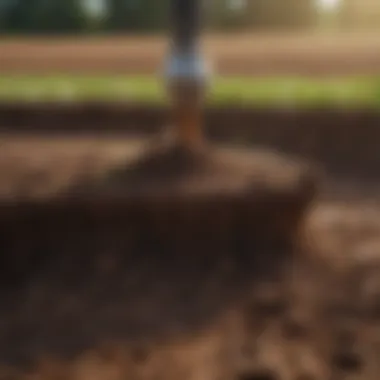Understanding Aeration's Role in Soil Health


Intro
Soil health is crucial for agricultural productivity. One of the most significant aspects of maintaining healthy soil is aeration. This process allows air to move through the soil, enabling various biological and chemical processes that are essential for plant growth. Without proper aeration, soil can become compacted, leading to poor drainage and inadequate root development. Thus, understanding aeration's importance is key for farmers, gardeners, and agricultural professionals.
Topic Overview
Definition and Importance
Soil aeration refers to the exchange of air in the soil profile. Good aeration promotes healthy bacteria and fungi, which are vital for nutrient cycling. Well-aerated soil allows roots to breathe, absorb moisture, and access nutrients more effectively. Conversely, poorly aerated soil leads to anaerobic conditions, which can stunt plant growth and increase the risk of diseases.
Brief History and Evolution
Historically, farmers have recognized the role of soil aeration. In ancient agrarian societies, practices like turning the soil were common to improve air circulation. Over time, technology has advanced. Modern innovations like core aeration equipment have made it easier to achieve optimal aeration levels.
Key Techniques and Innovations
Sustainable Farming Practices
Sustainable farming practices focus on enhancing soil aeration naturally. Some techniques include:
- Cover cropping: Planting cover crops helps maintain soil structure and promotes aeration.
- Crop rotation: Alternating crops cultivates diverse root systems that penetrate and aerate the soil.
- Reduced tillage: Minimizing tillage practice prevents soil compaction, maintaining better air circulation.
Advanced Agronomic Technologies
Innovations in agronomy also play a role in improving soil aeration. For instance:
- Soil aeration machines: These tools puncture the soil, creating small holes that facilitate air movement and water penetration.
- Soil sensors: Technology that monitors soil compaction levels helps farmers know when to aerate.
Practical Applications
Step-by-Step Guides
To aerate soil effectively, follow these steps:
- Identify compacted areas: Look for signs like poor drainage or stunted plant growth.
- Choose the right time: Aerate during the growing season when plants are actively growing.
- Use aeration tools: Depending on the area's size, use handheld tools or larger machines.
- Aerate thoroughly: Ensure even distribution of aeration holes across the area.
- Seed and fertilize: Follow up aeration with seed planting or applying fertilizers for immediate benefits.
Case Studies or Real-World Examples
For instance, a case study conducted on a corn farm in Indiana showed that after implementing core aeration techniques, yields increased by 15%. This practice improved root depth and hence efficient nutrient uptake.
Increasing soil aeration can play a vital role in achieving not just better plant growth but also sustainable practices for the future.
By understanding the significance of aeration and applying these techniques, farmers and gardeners can enhance their soil management efforts effectively.
Preface to Soil Aeration
Soil aeration is a crucial topic in the realm of agriculture and horticulture. It directly impacts soil health, plant growth, and overall ecosystem functionality. Aerating soil allows air, water, and nutrients to penetrate deeper, benefiting root systems and promoting a vibrant soil microbiome. This section lays a foundation for understanding how aeration plays a role in maintaining and improving soil quality, which is essential for anyone committed to sustainable farming practices.
Defining Soil Aeration
Soil aeration refers to the process of allowing air to enter and circulate within the soil. This is vital for maintaining the balance of gases—oxygen and carbon dioxide—within the soil profile. Oxygen is essential for the respiration of plant roots and soil organisms. When soil becomes compacted, these air passages become blocked, limiting the movement of gases and ultimately hindering plant growth.
Aeration can be achieved through various methods, including mechanical aeration and natural processes such as earthworm activity. The effectiveness of soil aeration is often linked to the soil's texture and structure, determining how well air and moisture can move through it.
Historical Perspective on Soil Management
Looking back, soil management practices have evolved significantly. Early agriculture focused primarily on the visible aspects of crop production and harvest yields, often neglecting the underlying health of the soil. For ancient civilizations, maintaining soil fertility primarily revolved around practices such as crop rotation and the application of organic matter.
As understanding of soil dynamics increased, innovative techniques were developed to tackle challenges associated with soil compaction and low aeration. The introduction of machinery in agriculture brought both benefits and drawbacks. While it improved efficiency, it also resulted in increased soil compaction, leading to further studies on aeration techniques. Consequently, soil management began to prioritize aeration as a means to enhance soil conditions, ensuring long-term productivity and sustainability.
Today, the importance of soil aeration is recognized not only for its immediate benefits but also for its role in fostering a healthy ecosystem. By understanding both the definition and historical context of soil aeration, practitioners can better appreciate how these practices directly influence plant health and agricultural outputs.
Why Aerate? The Fundamental Reasons
Aeration plays a crucial role in maintaining healthy soils that provide the necessary conditions for optimal plant growth. Understanding why aeration is vital goes beyond just the act of loosening soil. It encompasses the benefits that aeration brings to root development, water movement, and nutrient availability. These elements are interconnected and significantly impact the overall productivity of agricultural lands. This section highlights the importance of aeration through three key aspects: enhancing root growth, improving water infiltration, and facilitating nutrient availability.


Enhancing Root Growth
A robust root system is essential for plant health as it anchors the plant and absorbs water and essential nutrients. Aerating the soil allows for increased porosity, which leads to better air circulation and improved drainage. Roots require oxygen to thrive, and compacted soils can limit their growth due to reduced air pockets.
In turn, when soil is adequately aerated, roots can spread more freely, which promotes a healthy and extensive root network. A well-developed root system helps plants withstand stress better, such as drought or nutrient deficiencies. The practice of aeration can also encourage deeper root growth, making plants less susceptible to changes in surface moisture.
"Root health directly correlates with aerated soil conditions, emphasizing the importance of regular aeration practices in agricultural routines."
Improving Water Infiltration
Water infiltration refers to the movement of water into the soil. Compacted soil often leads to poor water infiltration, causing run-off and erosion. Aeration significantly improves this condition by breaking up compacted layers and enhancing the ability of the soil to absorb water effectively.
When aeration occurs, the formation of small channels is created, allowing water to penetrate and saturate the soil more evenly. This process also helps to reduce puddling and surface runoff, which in turn minimizes the loss of valuable topsoil. By improving water infiltration, crops can have better access to moisture during crucial growth phases. Additionally, adequate aeration helps to maintain moisture levels more consistently, benefiting both crops and the ecosystem.
Facilitating Nutrient Availability
Soil nutrients are vital for plant growth and health. Nutrients in the soil often become trapped in compacted areas, making them less accessible to plants. Aeration helps facilitate the movement of these nutrients by improving soil structure and health.
With aerated soil, beneficial microorganisms can thrive alongside plant roots, aiding in the breakdown of organic matter and making nutrients more bioavailable. The increased air circulation also promotes the chemical reactions necessary for nutrient assimilation. When aeration is performed regularly, the soil is enriched, leading to healthier plants and improved yields in the long run.
The Science Behind Aeration
The topic of aeration goes beyond simple gardening techniques. It embodies a scientific understanding of soil dynamics. Soil is not merely a medium that supports plants; it is a complex ecosystem. Aeration plays a pivotal role in maintaining this ecosystem's balance. Understanding the science of aeration helps in promoting soil health. It enhances root development, improves water retention, and allows for efficient nutrient uptake. Each of these elements contributes significantly to optimal plant growth and, ultimately, agricultural productivity.
Soil Composition and Structure
Soil is composed of various elements, including minerals, organic matter, air, and water. The ratios of these components shape the soil's physical structure. Healthy soil typically has a balanced mix of sand, silt, and clay. This composition creates a framework that allows for the necessary air spaces. These spaces are essential for aeration. If soil becomes too compacted, which often occurs after heavy rainfall or through foot traffic, it can restrict root growth. Consequently, plants struggle to absorb water and nutrients. Aeration serves to alleviate this compaction, thereby improving soil structure and facilitating better air circulation.
The Role of Soil Air Spaces
Air spaces within soil are vital for several reasons. First, they supply oxygen to plant roots and soil-dwelling organisms. Oxygen is crucial for aerobic respiration in roots, which in turn affects plant health. Furthermore, air spaces enable drainage, reducing the risk of waterlogging. Poor drainage can lead to anaerobic conditions, detrimental to root systems. When aeration is effectively practiced, these air spaces help to maintain an equilibrium between water retention and drainage. In many cases, it is this balance that determines the success of crop growth.
Microbial Activity and Aeration
Microbial life in soil is indispensable for nutrient cycling. Bacteria, fungi, and other microorganisms play a role in breaking down organic matter, releasing essential nutrients for plants. Aeration positively influences microbial activity by enhancing oxygen availability. When soil is compacted, anaerobic conditions may prevail, impeding microbial processes. This reduction in microbial activity can lead to fewer nutrients being available to plants, hampering their growth. Therefore, practicing aeration is not only beneficial for the plants themselves, but it also fosters a thriving microbial community in the soil.
"Healthy soil supports healthy plants, and aeration is a key factor in this relationship."
In summary, understanding the science behind aeration is crucial. The composition and structure of soil, the significance of air spaces, and the role of microorganisms all contribute to its health. Aeration practices can lead to enriched soil, which translates to enhanced plant growth and improved agricultural outcomes.
Types of Soil and Their Aeration Needs
Understanding the different types of soil and their specific aeration needs is crucial for optimizing soil health. Each soil type has its unique characteristics, affecting how air and water penetrate and retain within the soil matrix. Proper aeration is essential for promoting root growth, improving water drainage, and enhancing nutrient availability. Acknowledging these differences allows farmers and gardening enthusiasts to tailor their aeration practices for maximum effectiveness.
Sandy Soils
Sandy soils are known for their coarse texture, which allows for quick drainage. This inherent property can lead to aeration challenges, particularly in water retention. The large particles enable air movement but also create spaces where water can easily escape. Therefore, while sandy soils are often easy to aerate, maintaining moisture is vital. To address this, incorporating organic matter such as compost can enhance soil structure and improve retention. This combination of aeration and moisture management is critical in supporting plant health in sandy environments.
Clay Soils
Clay soils, in contrast to sandy soils, contain small particles that pack closely together. This compactness can lead to severe aeration issues. Poor air movement results in low oxygen levels, which can stunt plant growth and increase the likelihood of root rot. Aerating clay soils often requires mechanical methods to break up the dense structure, creating pathways for air and water. Adding gypsum can also help improve soil structure, making it less compact and more receptive to aeration. Understanding these properties is key for effective soil management in clay contexts.
Loamy Soils
Loamy soils are often regarded as the ideal growing medium. They combine sand, silt, and clay in proportions that provide good aeration and water-holding capacity. This balance allows for efficient nutrient uptake while minimizing compaction issues. However, even loamy soils can benefit from regular aeration practices, especially in heavy cultivation areas. Maintaining organic matter through routine amendments fosters microbial activity, which further enhances aeration and overall soil health. For farmers and gardeners, knowing how to protect and enhance loamy soil aeration is essential for maximizing productivity.
Aeration Techniques and Practices
Aeration is not just a necessity but is also a critical practice for preserving soil health. Understanding various aeration techniques and their applications can greatly benefit agricultural practices and result in healthier plants. Each method possesses unique advantages, yet the ultimate goal remains the same: promoting better air flow within the soil structure, enhancing root development, and improving water and nutrient absorption.
Mechanical Aeration Methods
Mechanical aeration involves using equipment to create holes or channels in the soil. This approach is particularly useful for large areas where labor-intensive methods may not be practical. Equipment such as core aerators or spike aerators can be employed to facilitate this process.
Core aeration removes small plugs of soil, allowing air to penetrate deeper into the root zone. This method is beneficial for compacted soils, as it alleviates pressure and increases porosity. Spike aeration, while simpler, can promote surface-level aeration but may not be as effective in heavily compacted situations.
Some key benefits of mechanical aeration methods include:


- Time efficiency: Covers larger areas in shorter time.
- Effective on various soil types: Works well for lawns, fields, and gardens.
- Long-lasting impact: Provides immediate improvements on soil structure.
Manual Aeration Techniques
Manual aeration techniques are usually more labor-intensive but allow for targeted aeration in specific areas. These methods are often favored in smaller gardens or plots where precision is required. Tools like hand-held aerators, garden forks, or pitchforks can be utilized effectively for these purposes.
By manually aerating, you can focus on areas that may need it the most, such as spots where water tends to pool or areas with a lot of foot traffic. Some advantages of manual aeration approaches include:
- Control: You can select specific areas for aeration.
- Cost-effective: Fewer resources are needed for small gardens.
- Minimal disturbance: Less invasive to surrounding plants and soil life.
Natural Aeration Approaches
Natural aeration methods leverage the environment to improve airflow within the soil. This is often accomplished by fostering the activities of earthworms and soil microorganisms that help create channels and voids in the soil. Practices like cover cropping and mulching can also enhance soil aeration over time.
Cover crops, such as clover or rye, can significantly contribute to soil structure, aiding natural aeration. These plants improve organic matter in the soil while their roots create pathways for air and water. Besides supporting aeration, natural methods bring other complementary benefits such as improved nutrient cycling and increased biodiversity.
Some strengths of natural aeration approaches:
- Sustainability: Reduces reliance on mechanical tools and chemicals.
- Improves overall soil quality: Supports the entire ecosystem.
- Long-term benefits: Enhances soil health over time, allowing for resilience against environmental stressors.
"Effective aeration is not just about the method used; it is about creating a holistic approach that integrates various practices to sustain soil health."
Aeration Frequency and Timing
Aeration frequency and timing are crucial components in maintaining optimal soil health. Both factors influence how effective the aeration process will be and ultimately affect the soil's ability to support plant life. Correct timing ensures that aeration aligns with key growth periods for crops and vegetation, making it essential for maximizing nutrient absorption and root expansion.
The frequency of aeration can vary based on the type of soil and its specific conditions. For instance, heavily compacted soils may require more frequent aeration compared to looser soils that may not compact as easily. As a general guideline, many farmers and gardeners benefit from aerating their lawns or cultivated areas at least once or twice a year. However, observing the specific needs of the soil over time allows for more tailored intervention.
Seasonal Considerations
Understanding the seasonal context is vital for effective aeration. Each season offers different challenges and opportunities for soil health. In spring, soils often need aeration as they prepare for planting. The moisture level tends to be higher, which can lead to compaction. Aerating at this time allows air to circulate, promoting root growth and preparing the ground for the introduction of seeds.
Autumn also presents an important window for aeration. Following the harvest, the soil can be treated to rejuvenate it for the next cycle. During this time, microbial activity tends to increase as the soil is warmed by residual heat. Aeration can enhance this process, supporting the breakdown of organic matter and improving soil structure.
"Timing your aeration to coincide with seasonal rhythms leads to healthier soils and more productive crops."
Understanding the weather patterns can also guide aeration practices. Avoiding aeration during extreme wet or dry conditions can prevent soil displacement and damage.
Monitoring Soil Conditions
Monitoring soil conditions is essential to determine when aeration is necessary. Regular soil testing provides insights into compactness, nutrient levels, and moisture content. Compacted soils often exhibit signs such as poor water drainage and reduced plant growth. If these symptoms are present, it is a clear indication that aeration should be implemented.
Additionally, consider the soil temperature and moisture levels prior to aeration. A well-drained soil with moderate moisture is ideal. Testing can be simple, and tools are available for measuring soil compaction. Farmers and gardeners should aim to aerate when conditions are suitable to avoid additional stress on the soil.
In summary, understanding aeration frequency and timing in soil management can enhance soil health. Adopting a strategic approach to aeration, aligned with seasonal changes and ongoing soil assessment, can significantly contribute to long-term agricultural success.
Economic Benefits of Aeration
Aeration is crucial in agriculture and gardening, and its economic benefits cannot be overlooked. This practice of improving the soil's air exchange and structure can lead to enhanced productivity and reduced costs over time. Understanding these economic aspects is essential for farmers and enthusiasts aiming for sustainable practices while maximizing yields.
Cost-Benefit Analysis
When assessing the economic viability of soil aeration, a cost-benefit analysis can provide substantial insights. Implementing aeration methods incurs initial costs, such as purchasing equipment or hiring services. However, these expenses can be recuperated through increased crop yields and reduced input costs.
For instance, more oxygen in the soil promotes healthier roots, resulting in better plant growth. Healthier plants tend to utilize fertilizers more efficiently, lowering the overall amounts required. In many cases, the increased harvest yields can outweigh the costs associated with aeration, making this practice a financially sound investment.
Key factors in cost-benefit analysis include:
- Initial Cost: Equipment, labor, and materials needed for aeration.
- Yield Increases: Measured in additional crop output resulting from improved soil conditions.
- Input Reductions: Savings from cutbacks on fertilizers and water due to more efficient usage.
Long-term Productivity Gains
Aeration extends beyond immediate gains by contributing to long-term soil health and productivity. Regular aeration can enhance the soil structure, creating resilient environments for root systems. This resilience means crops can withstand stressors like drought or pest infestations more effectively.
Over time, the benefits compound. Frequent aeration improves soil organic matter, nutrient cycling, and the overall biological activity in the soil. Farmers who invest in aeration often notice a sustained increase in productivity. This long-term perspective reshapes the economics of farming, where the initial costs of aeration become a small price to pay for yielding crops that demand less fertilization and fewer resources overall.
"Investing in aeration translates not just to immediate economic benefits but lays the groundwork for sustainable farming practices that yield long-term viability."


Challenges in Soil Aeration
Aerating soil is vital for enhancing its health and productivity, yet several challenges may hinder successful aeration. Understanding these challenges can allow farmers and gardening enthusiasts to navigate them effectively. This section delves into the critical issues like soil compaction and environmental factors that affect aeration practices.
Soil Compaction Issues
Soil compaction is a primary obstacle in effective soil aeration. It occurs when soil particles are pressed closely together, reducing porosity and the availability of air spaces. This leads to insufficient oxygen for root systems, which is detrimental to plant health.
Compacted soil may also impede water infiltration and drainage, resulting in surface runoff and increased erosion. The roots of plants struggle to grow through dense layers, leading to stunted growth and vulnerability to disease.
Several factors can contribute to soil compaction, such as heavy machinery, foot traffic, and insufficient organic matter. Addressing soil compaction requires immediate action, such as:
- Reducing vehicle traffic on fields or garden beds.
- Incorporating organic matter like compost or mulch to increase soil structure.
- Implementing cover crops that improve soil health and aeration.
Proactively managing soil compaction is essential for sustainable agriculture, ultimately fostering healthier crops and better yields.
Environmental Factors Affecting Aeration
Environmental conditions can significantly impact soil aeration. Factors such as moisture levels, temperature, and soil type play a crucial role in determining how air moves through soil.
- Moisture Content: Excess moisture can lead to anaerobic conditions, where the soil lacks oxygen. This can hinder microbial activity and affect nutrient cycling.
- Temperature Variations: Temperature influences soil biology. Warmer soil generally promotes microbial activity, enhancing aeration but can also lead to faster decomposition of organic matter.
- Soil Type: Different soil types have unique aeration requirements. For instance, sandy soils typically drain well but can become overly dry, while clay soils retain moisture but can become compacted easily.
Understanding these environmental factors allows for more tailored aeration approaches. For example, adjusting aeration practices to coincide with dry periods may avoid creating further compaction issues in wetter soils.
"The balance between maintaining soil moisture and ensuring adequate aeration is crucial for optimal plant growth."
In summary, recognizing and addressing the challenges in soil aeration is vital for any individual looking to enhance soil health. Studying compaction and environmental conditions is necessary for implementing effective aeration strategies.
The Future of Soil Aeration Practices
The future of soil aeration practices holds significant importance in achieving sustainable agriculture. As farmers and gardening enthusiasts face changing climate conditions and soil health challenges, innovative approaches will become crucial. This section focuses on emerging trends, technology, and research that could enhance aeration practices, making them more efficient and applicable in diverse environments.
Innovations in Aeration Technology
Recent advancements in aeration technology introduce several promising tools and methods to improve soil health. For instance, new aeration machines are now equipped with sensor technology. These sensors can analyze soil conditions in real time, allowing for targeted aeration to occur precisely where it is needed. The use of GPS tracking in these machines also enables efficient operation, reducing time and labor costs.
Another noteworthy development is the integration of drones in soil aeration. Drones can evaluate large agricultural areas, mapping the topography and identifying compaction zones. By acquiring aerial data, farmers can make more informed decisions regarding when and where to aerate.
Additionally, there are biodegradable materials that can be used to create aeration spikes or plugs, promoting aeration without leaving long-term environmental effects. Using natural materials reduces chemical inputs and supports sustainability in farming practices.
"Innovative approaches in soil aeration technology will be essential to meet the demands of modern agricultural practices while maintaining soil health."
Research Trends in Soil Management
Current research in soil management emphasizes understanding soil microbe interactions and their role in aeration. Studies show that well-aerated soils support beneficial microbial life, which contributes positively to nutrient cycling. This biotic activity drives the need for more research on the right balance between aeration practices and microbial health.
Moreover, research focuses on the impact of soil amendments combined with aeration. For example, integrating organic matter into the soil can enhance its structure. Improved structure can facilitate air and water movement, working in conjunction with aeration.
Furthermore, interdisciplinary studies are emerging, combining agronomy, environmental science, and technology. Researchers are looking into how climate change affects soil properties and aeration requirements, leading to adaptive management strategies.
End
Soil aeration is a crucial aspect of soil management that receives attention in this article. Understanding the principles and practices surrounding aeration can profoundly impact plant health and agricultural productivity. Through aeration, farmers and gardeners can enhance root systems, improve water retention, and increase nutrient availability. All these factors align to support overall soil health.
Summarizing Key Points
Several key points emerge from the exploration of soil aeration. Firstly, aeration facilitates the exchange of gases within the soil, ensuring that roots have sufficient oxygen. This is vital for root growth and development. Secondly, aeration improves water infiltration, reducing runoff and maximizing moisture retention in the soil. This is especially important during dry periods when plants rely on consistent water access.
Moreover, aeration encourages a diverse microbial ecosystem, which plays a significant role in nutrient cycling. Healthy soil microorganisms break down organic matter, releasing essential nutrients for plants.
- Enhances root development
- Improves water infiltration
- Facilitates nutrient availability
- Promotes healthy soil microbiomes
As farmers and gardeners embrace targeted aeration practices, they cultivate stronger, more resilient plants. This is financially beneficial as well since enhancing soil aeration can lead to increased crop yields over time.
Final Thoughts on Aeration’s Importance
In summary, the importance of aeration in soil health cannot be understated. It is not merely about loosening soil; it is about fostering an environment conducive to plant growth and sustainability. As agricultural practices evolve, adopting innovative aeration techniques will become increasingly vital for maintaining soil health in various ecosystems.
For those involved in agriculture, understanding how aeration can positively impact soil conditions is essential for long-term productivity. Embracing these practices highlights a commitment to responsible stewardship of land resources.
"Healthy aerated soil is the foundation for thriving crops, enhancing not only yields but ecological balance."
Through careful management of soil aeration, farmers and enthusiasts can cultivate an enriching environment for both plants and soil organisms. This practice serves as a cornerstone for successful agricultural outcomes.



